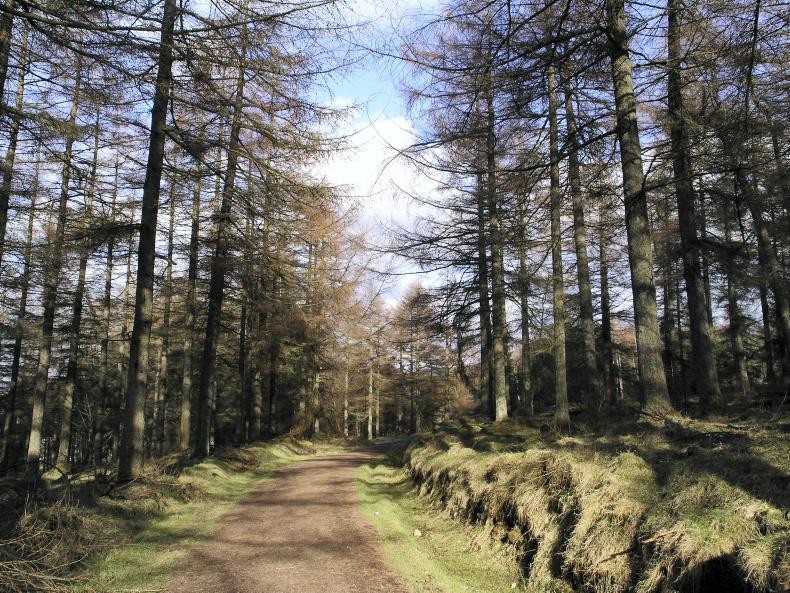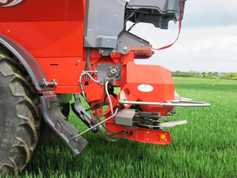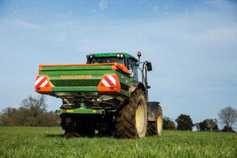When the annual State forest premium payments end, thinning revenue should begin in most commercial forests to ensure continuity of income over the life of the crop.
Farmers with forests planted up to 2015 receive annual State payments for 20 years while those who planted since 2015 will receive payments for 15 years.
Thinnings
Revenue from thinning is usually spaced out at five-year intervals before clearfelling or final harvesting. While thinning revenue provides a regular income, clearfelling provides the big payday, which needs to fund the cost and maintenance of the replacement forest and a period of non-revenue before the reforested area provides an income.
In most productive conifer forests, clearfell takes place between years 28 and 40 depending on yield, species, windthrow risk and management objectives.
Forest owners who don’t fully understand yield and yield class (YC) are often tempted to clearfell early, which is a mistake unless the crop is vulnerable to windblow.
YC is an estimate of the potential maximum mean annual increment in cubic metres per hectare per annum (m³/ha/yr).
YC is referred to as the average annual volume per hectare of a crop which is only true if the total rotation of the crop is taken into account.
For example, a YC24 Sitka spruce produces an average yield of 24m3/ha if it is allowed to grow on to year 46 or the age of maximum mean annual volume increment ( MMAI), also referred to as biological rotation age.
Virtually all foresters and forest owners now clearfell in advance of the age of MMAI. Reasons for reducing rotations include:
Yield: productive forests produce temptingly high yields early.Cashflow: relatively high income can be achieved from premature clearfells. Growers may wish to “cash in” their crops early for financial reasons.Markets: sawmills prefer medium to large timber as their technology is not suitable to handle very large logs so timber prices per cubic metre don’t necessarily increase as log sizes increase.Windblow risk: allowing a forest to grow to MMAI places it at risk of windblow as top height at that stage is likely to be well over 20m which is high risk especially in wind vulnerable sites.Yield
High-yielding crops produce highest volumes between years 20 and 30, so many growers are tempted to clearfell during this period.
However, by felling too early as Table 1 illustrates, the grower is missing out on future high-volume and high-quality production.
In this scenario, the annual volume growth from years 20 to 45 is assessed at five-year cycles for a YC24 Sitka spruce crop. Annual current volume production is highest from years 25 to 35 with yields at 28m3/ha allowing for 10% unstocked area (roads, ditches, diverse species, streams, open ground, etc.).
By clearfelling at age 25, the forest owner has removed 350m3/ha (including a first thinning). However, the owner could have increased yield per hectare by 145m3 and income by €9,500 , by waiting for a further five years.
By delaying thinning until year 40, both income and yield could almost be trebled.
Cashflow
The owner who clearfells at year 25 will argue that time has a money value and an early income of €11,500/ha sounds attractive.
For a 20ha crop, this amounts to a €230,000 tax-free windfall. However, when the €60,000 cost of reforestation is deducted and the 15-year wait for the next crop to produce thinnings is factored in, this early income soon loses its lustre.
Instead, if the owner waits and decides to keep thinning over this non-productive 15 years, cumulative earnings at year 40 would have almost trebled to €32,300/ha including an average regular income stream €1,160 every five years from thinning.
The 20ha forest owner’s cumulative earnings have now reached €646,000, well worth the wait considering the rock bottom deposit rates for most saving schemes.
Markets
The sawmill preference for timber averaging between 0.4m3 and 0.8m3 is cited as a reason to fell early as sawmill technology is geared to cut logs in this size range.
While it is true that large log sizes don’t necessarily command pro rata prices, both Coillte and private sale prices for large timber size categories – averaging over 1m3 – are often higher than medium log sizes and rarely appreciably less.
Therefore, reducing rotations because demand and prices may decrease considerably for large log sizes doesn’t stand up to market scrutiny at national level.
There is no doubt that the sawmill preference is for average tree sizes in the 0.4m3 to 0.8m3 range as this is where the greatest demand lies.
These are the log sizes that allow sawmills to produce popular sawn timber sizes such as 4.8m lengths at 100x22mm and 100x44mm width and thickness dimensions.
As the rotation extends to 40 years an increasing number of logs will be over 1m3, so the customer base narrows to the smaller number of sawmills that are geared to handle logs of this size. However, high demand and prices for all log sizes are likely to continue in Ireland.
Windblow
Reducing rotations because of windblow risk is an acceptable reason for premature clearfells, especially in fast-growing crops on vulnerable sites. Early and regular thinning will reduce the risk of windblow, but Storm Darwin in 2014 was a reminder of the need to consider the risk of windthrow when planning final harvest especially on exposed sites with shallow or wet soils.
A YC24 Sitka spruce crop will achieve a top height of 30m at full rotation of 45 years, which is regarded as low risk on well sheltered wind-firm sites but most sites in Ireland carry some degree of wind damage risk.
Reducing this rotation length to 34 years when the crop has a top height of 25m may be considered in medium-risk sites, while on very wind-vulnerable sites, it may be advisable to clearfell earlier, before the crop top height exceeds 20m.
Conclusion
In wind-firm sites, it makes silvicultural, economic and environmental sense to allow crops to reach at least 80% of full rotation age or clearfell between ages 35 and 40 for most high-yielding conifers including Sitka spruce, Norway spruce and Douglas fir.
As outlined, highly productive Sitka spruce YC24 achieves maximum income when clearfelled from years 35 to 40 (Table 1).
Table 1 shows the benefits of maximising yield and income by increasing rotation lengths. This approach also has environmental benefits, especially in relation to climate change mitigation. Extending the rotation increases the period of carbon sequestration in the forest, while end-products from older forests end up in construction and other long-service materials which ensures that the carbon remains fixed for long periods.

Read More
Forestry planting sees a 14% reduction in 2017
Climate change will change the way we use our land – Climate Council
When the annual State forest premium payments end, thinning revenue should begin in most commercial forests to ensure continuity of income over the life of the crop.
Farmers with forests planted up to 2015 receive annual State payments for 20 years while those who planted since 2015 will receive payments for 15 years.
Thinnings
Revenue from thinning is usually spaced out at five-year intervals before clearfelling or final harvesting. While thinning revenue provides a regular income, clearfelling provides the big payday, which needs to fund the cost and maintenance of the replacement forest and a period of non-revenue before the reforested area provides an income.
In most productive conifer forests, clearfell takes place between years 28 and 40 depending on yield, species, windthrow risk and management objectives.
Forest owners who don’t fully understand yield and yield class (YC) are often tempted to clearfell early, which is a mistake unless the crop is vulnerable to windblow.
YC is an estimate of the potential maximum mean annual increment in cubic metres per hectare per annum (m³/ha/yr).
YC is referred to as the average annual volume per hectare of a crop which is only true if the total rotation of the crop is taken into account.
For example, a YC24 Sitka spruce produces an average yield of 24m3/ha if it is allowed to grow on to year 46 or the age of maximum mean annual volume increment ( MMAI), also referred to as biological rotation age.
Virtually all foresters and forest owners now clearfell in advance of the age of MMAI. Reasons for reducing rotations include:
Yield: productive forests produce temptingly high yields early.Cashflow: relatively high income can be achieved from premature clearfells. Growers may wish to “cash in” their crops early for financial reasons.Markets: sawmills prefer medium to large timber as their technology is not suitable to handle very large logs so timber prices per cubic metre don’t necessarily increase as log sizes increase.Windblow risk: allowing a forest to grow to MMAI places it at risk of windblow as top height at that stage is likely to be well over 20m which is high risk especially in wind vulnerable sites.Yield
High-yielding crops produce highest volumes between years 20 and 30, so many growers are tempted to clearfell during this period.
However, by felling too early as Table 1 illustrates, the grower is missing out on future high-volume and high-quality production.
In this scenario, the annual volume growth from years 20 to 45 is assessed at five-year cycles for a YC24 Sitka spruce crop. Annual current volume production is highest from years 25 to 35 with yields at 28m3/ha allowing for 10% unstocked area (roads, ditches, diverse species, streams, open ground, etc.).
By clearfelling at age 25, the forest owner has removed 350m3/ha (including a first thinning). However, the owner could have increased yield per hectare by 145m3 and income by €9,500 , by waiting for a further five years.
By delaying thinning until year 40, both income and yield could almost be trebled.
Cashflow
The owner who clearfells at year 25 will argue that time has a money value and an early income of €11,500/ha sounds attractive.
For a 20ha crop, this amounts to a €230,000 tax-free windfall. However, when the €60,000 cost of reforestation is deducted and the 15-year wait for the next crop to produce thinnings is factored in, this early income soon loses its lustre.
Instead, if the owner waits and decides to keep thinning over this non-productive 15 years, cumulative earnings at year 40 would have almost trebled to €32,300/ha including an average regular income stream €1,160 every five years from thinning.
The 20ha forest owner’s cumulative earnings have now reached €646,000, well worth the wait considering the rock bottom deposit rates for most saving schemes.
Markets
The sawmill preference for timber averaging between 0.4m3 and 0.8m3 is cited as a reason to fell early as sawmill technology is geared to cut logs in this size range.
While it is true that large log sizes don’t necessarily command pro rata prices, both Coillte and private sale prices for large timber size categories – averaging over 1m3 – are often higher than medium log sizes and rarely appreciably less.
Therefore, reducing rotations because demand and prices may decrease considerably for large log sizes doesn’t stand up to market scrutiny at national level.
There is no doubt that the sawmill preference is for average tree sizes in the 0.4m3 to 0.8m3 range as this is where the greatest demand lies.
These are the log sizes that allow sawmills to produce popular sawn timber sizes such as 4.8m lengths at 100x22mm and 100x44mm width and thickness dimensions.
As the rotation extends to 40 years an increasing number of logs will be over 1m3, so the customer base narrows to the smaller number of sawmills that are geared to handle logs of this size. However, high demand and prices for all log sizes are likely to continue in Ireland.
Windblow
Reducing rotations because of windblow risk is an acceptable reason for premature clearfells, especially in fast-growing crops on vulnerable sites. Early and regular thinning will reduce the risk of windblow, but Storm Darwin in 2014 was a reminder of the need to consider the risk of windthrow when planning final harvest especially on exposed sites with shallow or wet soils.
A YC24 Sitka spruce crop will achieve a top height of 30m at full rotation of 45 years, which is regarded as low risk on well sheltered wind-firm sites but most sites in Ireland carry some degree of wind damage risk.
Reducing this rotation length to 34 years when the crop has a top height of 25m may be considered in medium-risk sites, while on very wind-vulnerable sites, it may be advisable to clearfell earlier, before the crop top height exceeds 20m.
Conclusion
In wind-firm sites, it makes silvicultural, economic and environmental sense to allow crops to reach at least 80% of full rotation age or clearfell between ages 35 and 40 for most high-yielding conifers including Sitka spruce, Norway spruce and Douglas fir.
As outlined, highly productive Sitka spruce YC24 achieves maximum income when clearfelled from years 35 to 40 (Table 1).
Table 1 shows the benefits of maximising yield and income by increasing rotation lengths. This approach also has environmental benefits, especially in relation to climate change mitigation. Extending the rotation increases the period of carbon sequestration in the forest, while end-products from older forests end up in construction and other long-service materials which ensures that the carbon remains fixed for long periods.

Read More
Forestry planting sees a 14% reduction in 2017
Climate change will change the way we use our land – Climate Council







 This is a subscriber-only article
This is a subscriber-only article











SHARING OPTIONS: